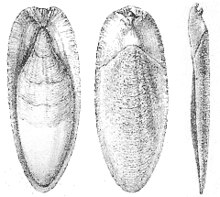




Cuttlebone, also known as cuttlefish bone, is a hard, brittle internal structure (an internal shell) found in all members of the family Sepiidae, commonly known as cuttlefish, within the cephalopods. In other cephalopod families it is called a gladius.
Cuttlebone is composed primarily of aragonite. It is a chambered structure that the animal can fill with gas or liquid for buoyancy control. On the ventral (bottom) side of the cuttlebone is the highly modified siphuncle; this is the organ with which the cuttlebone is filled with gas or liquid.[2] The microscopic structure of cuttlebone consists of narrow layers connected by numerous upright pillars.
Depending on the species, cuttlebones implode at a depth of 200 to 600 metres (660 to 1,970 ft). Because of this limitation, most species of cuttlefish live on the seafloor in shallow water, usually on a continental shelf.[3]
When the cuttlefish dies, only the cuttlebone remains and will often wash up on a beach.
- ^ Fuchs, D.; Engeser, T.; Keupp, H. (2007). "Gladius shape variation in coleoid cephalopod Trachyteuthis from the upper Jurassic nusplingen and Solnhofen plattenkalks" (PDF). Acta Palaeontologica Polonica. 52 (3): 575–589.
- ^ Rexfort, A.; Mutterlose, J. (2006). "Stable isotope records from Sepia officinalis — a key to understanding the ecology of belemnites?". Earth and Planetary Science Letters. 247 (3–4): 212. Bibcode:2006E&PSL.247..212R. doi:10.1016/j.epsl.2006.04.025.
- ^ Norman, M.D. (2000). Cephalopods: A world guide. Conch Books.

